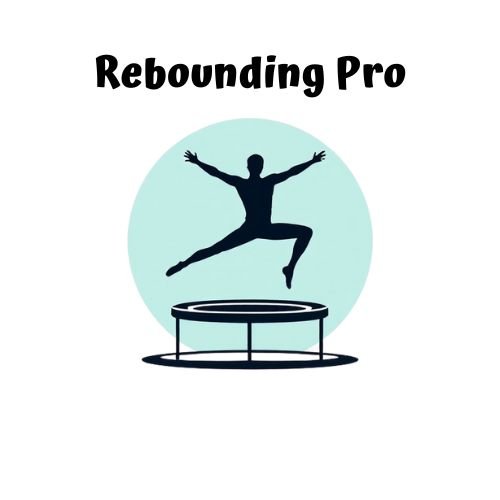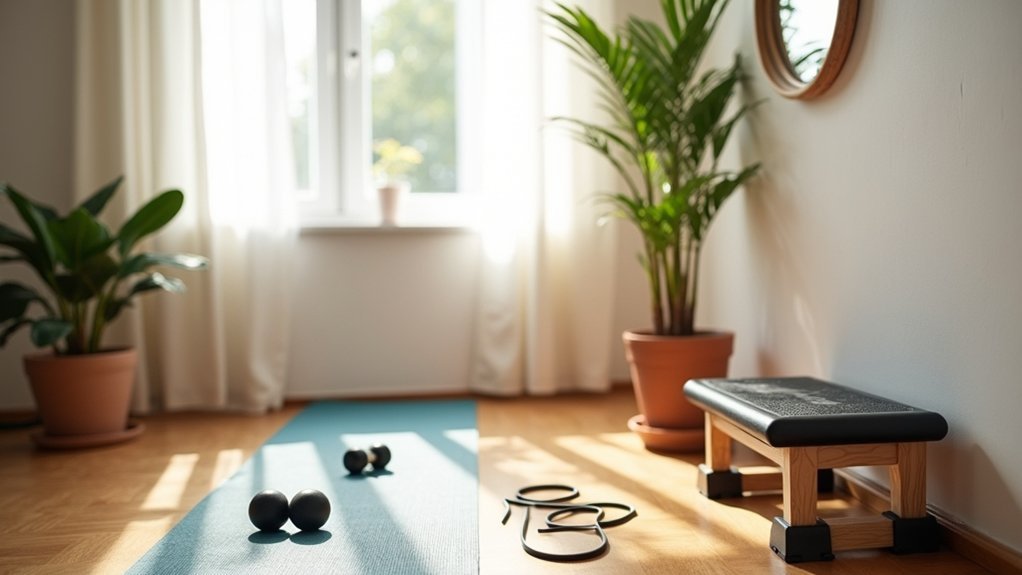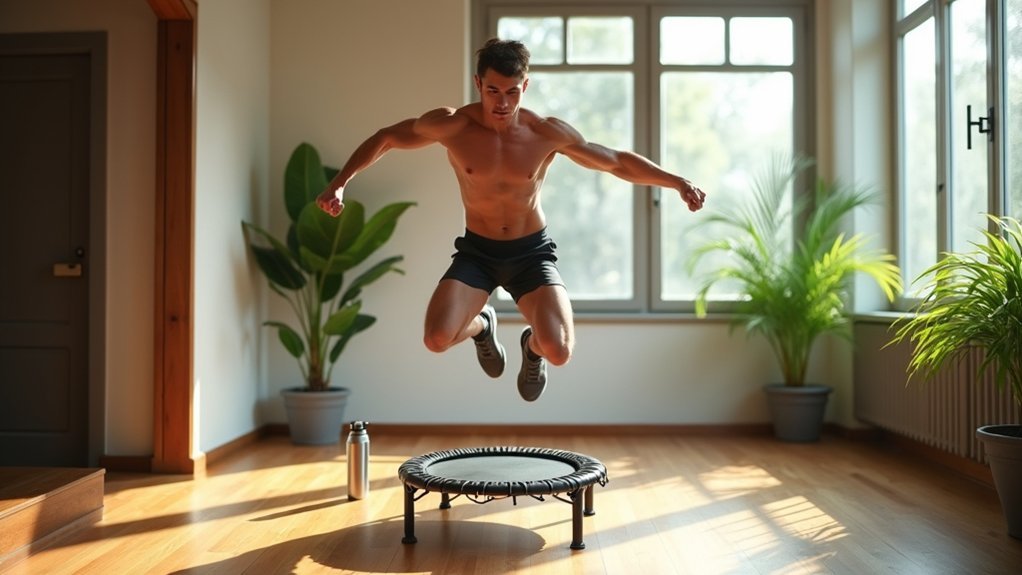Morning rebounding on a mini-trampoline can transform your energy levels and kickstart your day. This low-impact exercise boosts circulation, activates your lymphatic system, and releases mood-enhancing hormones in just 5 minutes. Start with gentle bounces and gradually add knee raises or star jumps as you progress. Pairing rebounding with strength moves maximizes metabolism and detoxification benefits. Discover how this simple morning ritual can revolutionize your entire day.
The Science Behind Rebounding’s Morning Energy Boost

While many people reach for coffee to kickstart their day, rebounding offers a natural, powerful alternative that transforms your body from the inside out. This gentle bouncing exercise stimulates your cardiovascular system, increasing oxygen circulation throughout your body and immediately boosting your energy levels.
When you rebound in the morning, you’re activating your lymphatic system, which helps remove toxins that can contribute to fatigue. The increased production of serotonin and dopamine—your body’s natural mood elevators—creates a positive mental state to start your day. This low-impact exercise is suitable for people of all ages, making it accessible to everyone regardless of fitness level.
Your brain benefits too, as improved oxygenation enhances cognitive function and mental clarity. The combination of better circulation, neurotransmitter release, and gentle full-body movement creates sustained energy that coffee simply can’t match.
Essential 5-Minute Bounce Routine for Busy Mornings
When time is at a premium but energy is essential, this 5-minute bounce routine delivers maximum results with minimal commitment. Your rebounder needs no setup—just step on and begin with basic bounces, feet slightly apart and knees softly bent.
Alternate between gentle bounces and more dynamic movements: lift your feet alternately, add knee raises to intensify the workout, and incorporate occasional star jumps to boost calorie burn. This sequence activates your lymphatic system, engages your core and leg muscles, and immediately elevates your heart rate.
Mix gentle bounces with dynamic movements to activate lymphatic flow, strengthen your core, and instantly raise your heart rate.
You’ll notice both physical and mental benefits—improved circulation, enhanced focus, and a mood-lifting endorphin release. Combine movement with positive affirmations to create a truly transformative morning experience.
The routine works for all fitness levels; simply adjust your bounce height and speed to match your capabilities. No special skills required—just five minutes to transform your morning energy.
Progressive Intensity: Building Your Morning Jump Sequence

Progressive intensity transforms an ordinary morning jump routine into a systematic energy-building sequence that maximizes both your workout effectiveness and safety.
Begin with a proper 10-15 minute warm-up including mobility exercises and light cardio to prepare your body for impact.
Build your jump sequence by following these key progression steps:
- Start low – Begin with simple hops or small squat jumps to engage muscles without strain.
- Increase gradually – Add height, speed, or complexity only after mastering simpler movements.
- Incorporate strength – Weave in complementary exercises like lunges and planks to support jump performance. Include the McGill Big 3 exercises to develop core stability essential for jump performance and injury prevention.
Monitor your fatigue levels and adjust rest periods accordingly.
This stepwise approach prevents injury while systematically developing power and endurance—ensuring your morning routine delivers consistent energy without excessive soreness.
Combining Rebounding With Strength Moves for Total Body Awakening
You’ll transform your morning routine when you pair rebounding with strength exercises, creating a metabolism-boosting powerhouse that continues burning calories hours after your workout.
The mini-trampoline provides an excellent base for combining jumping movements with resistance training, engaging multiple muscle groups while minimizing joint impact. Additionally, this low-impact workout is easy on joints compared to traditional cardio exercises, making it suitable for people of all fitness levels.
This full-body circuit approach not only wakes up every muscle fiber but also optimizes your body’s fat-burning potential right at the start of your day.
Boosting Metabolism Effectively
Combining rebounding with strength movements creates a metabolic powerhouse that transforms sluggish morning energy into sustained all-day vigor.
This duo activates your metabolism through multiple pathways—cardiovascular stimulation from rebounding paired with muscle engagement from strength training triggers EPOC, keeping your calorie burn elevated hours after you’ve finished.
Morning workouts leverage your body’s hormone sensitivity after fasting, optimizing fat oxidation while building metabolism-boosting muscle tissue. The routine helps overcome feelings of disconnect that often accompany sedentary morning routines.
For maximum metabolic impact:
- Alternate 30 seconds of rebounding with 30 seconds of strength moves like squats or push-ups
- Maintain elevated heart rate throughout to extend fat-burning benefits
- Include full-body movements that engage multiple muscle groups simultaneously
These combined routines not only burn calories during exercise but enhance your resting metabolic rate long-term through increased muscle mass.
Mini-Trampoline Circuit Benefits
Mini-trampoline circuits elevate traditional strength training by creating a dynamic, unstable platform that engages multiple body systems simultaneously. When you combine rebounding with strength moves, you’ll experience enhanced balance, lymphatic drainage, and cardiovascular efficiency—all with minimal joint impact. The low-impact cardio nature of trampoline workouts protects your joints while still delivering excellent fitness results.
| Circuit Component | Primary Benefit | Time Recommendation |
|---|---|---|
| Balance Sequences | 35% fall risk reduction | 5 minutes daily |
| Lymphatic Bounces | Toxin clearance & immunity | 10-15 minutes |
| Cardio Intervals | VO2 max improvement | 8-12 minutes |
| Strength Integration | Bone density & muscle tone | 10 minutes |
These workouts activate stabilizing muscles through g-force variations while stimulating lymph valve function. You’ll burn calories comparable to jogging but with 80% less joint strain—making this an ideal morning routine for total body awakening regardless of fitness level.
Lymphatic Activation: How Morning Bouncing Detoxifies Your System

Your morning bounce session kickstarts your lymphatic system, creating a pumping action that moves toxin-filled fluid through vessels that lack their own pump.
Each jump opens and closes lymphatic “gates,” promoting efficient waste removal and toxin clearance throughout your body.
This 10-15 minute routine not only energizes you but also primes your immune system for the day by enhancing cellular detoxification and lymphatic circulation. Unlike high-impact exercises, rebounding is easier on joints while still providing significant cardiovascular benefits.
Lymphatic Circulation Boost
While most people associate bouncing with childhood fun, this simple movement delivers a powerful health boost by activating your lymphatic system—the body’s natural detoxification network.
Unlike your cardiovascular system, your lymphatic system lacks a pump, relying entirely on physical movement to circulate properly.
Just a few minutes of morning bouncing creates a powerful pumping effect that:
- Triples your white blood cell count for up to an hour, strengthening immune response
- Flushes cellular waste and toxins from tissues, reducing puffiness and swelling
- Activates millions of one-way valves in lymph vessels, improving overall circulation
Landing on a mini-trampoline creates twice the gravity force, making rebounding more effective than running for lymphatic stimulation. This gentle impact exercise is easier on your joints than hard-surface workouts while still delivering profound detoxification benefits that leave you feeling energized and refreshed all day.
Toxin Clearance Benefits
Beyond simply energizing your morning, consistent bouncing serves as a powerful detoxification method that systematically purges your body of accumulated waste. Each bounce activates one-way lymphatic valves, increasing lymph flow up to 30 times normal rates, efficiently removing toxins and cellular debris from interstitial spaces.
This rebounding action is remarkably effective—studies show it’s 68% more efficient than jogging for lymphatic detoxification with considerably less skeletal impact. As you bounce, you’re creating intermittent gravitational forces that prevent fluid stagnation while flushing toxins through lymph nodes toward excretory organs. The Health Bounce technique keeps your feet low to the mat, making it an accessible option for beginners and those with joint concerns.
The benefits extend beyond detoxification. Your enhanced lymphatic circulation supports immune surveillance, reduces chronic inflammation, and improves metabolic function.
Mindful Rebounding: Meditative Jumping Practices to Start Your Day
Transforming your morning trampoline session into a mindful practice can revolutionize how you begin each day. By integrating conscious breathing with your rebounds—inhaling as you rise and exhaling as you descend—you’ll anchor your awareness to the present moment while energizing your system.
The weightlessness awareness technique utilizes those micro-moments of suspension at the peak of each bounce to cultivate presence and mental clarity. Try Tony Robbins’ priming adaptation or the five-minute energy circles (480 jumps) to balance your pituitary stimulation through specific breathing patterns. This exercise helps reduce mistakes at work by improving concentration, ultimately leading to less stress in your daily life.
For beginners, start with these foundational practices:
- Basic bounce walks with full-body awareness
- Wide marching variations with synchronized breathing
- Light beam visualization cycling energy from crown to earth
For best results, jump barefoot to enhance sensory connection with the mat.
Advanced Choreographed Sequences for Experienced Rebounders
Moving from mindful morning practices to more challenging territory, experienced rebounders can elevate their routines through sophisticated choreographed sequences.
These 30-45 minute workouts combine sustained cardio intervals with strength conditioning, particularly targeting your core.
You’ll master fluid shifts between bouncing and static exercises while synchronizing arm movements with complex footwork. The dynamic leg actions and explosive core-engagement moves greatly improve your cardiovascular endurance and muscular strength.
For peak performance, invest in specialized rebounders like Maximus Pro models that withstand aggressive sequences with firm bounce and stability.
Learn progressively by breaking choreography into smaller phrases before increasing speed. Following structured formats like Tabata style exercises can maximize intensity while providing necessary recovery intervals.
These advanced routines not only burn more calories than simple rebounding but also enhance proprioception while reducing joint stress through the rebounder’s shock absorption capabilities.
Rebounding Safety Tips and Form Fundamentals for Beginners
Safety forms the foundation of any effective rebounding practice, especially for newcomers to this energizing exercise form. Before you begin, verify your trampoline is properly assembled on a level surface and always perform pre-use checks.
Safety first—always ensure proper assembly and pre-use checks before stepping onto your trampoline.
When jumping, maintain proper alignment by keeping:
- Feet hip-width apart with weight evenly distributed
- Knees slightly bent (never locked)
- Core engaged with a neutral spine
Focus your gaze forward on a fixed focal point to maintain proper posture and balance throughout your workout.
Start with micro jumps and gradually increase intensity. Don’t bounce on the balls of your feet—instead, distribute weight evenly across your entire foot. Consider using safety bars for extra stability if you’re just beginning.
Listen to your body and stop if you experience discomfort. Incorporate health bounces (gentle bounces) at the beginning and end of each session to prepare and cool down properly.
Tracking Your Progress: Measuring the Impact of Consistent Morning Bouncing
As you establish your morning rebounding routine, tracking your progress becomes essential to staying motivated and maximizing results. Commit to consistency with two 10-minute sessions daily, adjusting as needed based on your body’s signals.
Record quantifiable metrics like jump height, duration, and number of successful rebounds to provide clear indicators of improvement. Consider using wearable sensors or fitness apps to monitor your movement patterns and intensity levels for more precise feedback.
Don’t overlook subjective indicators—note changes in your energy levels, mood, and recovery times. These personal observations often reveal benefits before numerical data does. Remember that daily practice helps ensure you achieve optimal fitness outcomes and maintain steady improvement over time.
Monitor physiological changes through periodic measurements of cardiovascular markers and body composition to understand your rebounding routine’s full impact on your health.
Frequently Asked Questions
Can Rebounding Help With Specific Joint Pain or Arthritis?
Yes, rebounding can help with joint pain and arthritis. It’s low-impact, reduces strain on your joints, and studies show it improves mobility and strength while decreasing pain for many arthritis sufferers.
How Does Rebounding Compare to Running for Joint Impact?
Rebounding causes up to 85% less joint strain than running. You’ll experience distributed impact throughout your body rather than concentrated force on your knees and ankles, allowing for more frequent workouts with less recovery time.
When Will I Start Noticing Cognitive Benefits From Morning Rebounding?
You’ll likely notice cognitive benefits from morning rebounding within three weeks, with improvements in attention and processing speed. As you continue, you’ll experience enhanced cognitive flexibility, working memory, and problem-solving skills.
Can Rebounding Help With Weight Loss or Body Composition?
Yes, rebounding can help with weight loss and body composition. You’ll burn calories, build muscle tone, boost metabolism, and improve insulin sensitivity. With consistency, you’ll likely see changes within 12-20 weeks of regular workouts.
Are There Age Restrictions for Starting a Rebounding Routine?
There aren’t specific age restrictions for rebounding. You can start at any age, from children to seniors. Just begin slowly, adapt exercises to your ability level, and consult a doctor if you have health concerns.
In Summary
You’ve discovered the transformative power of morning rebounding! Whether you’re a novice or seasoned jumper, your consistent practice energizes, detoxifies, and strengthens your body in just minutes each day. As you continue this journey, you’ll notice improved energy levels, better mental clarity, and enhanced physical fitness. Keep tracking your progress—your future self will thank you for the simple decision to start each day with a bounce!





Leave a Reply